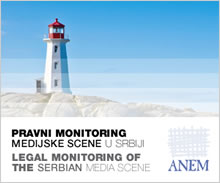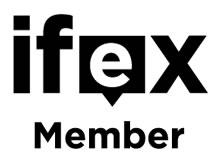10. 05. 2010
NINTH MONITORING REPORT
ANEM presents the Ninth Report on legal monitoring of the Serbian media scene in! The report is the result of the monitoring carried out in March by the expert team. Their findings suggest that in this period, the media situation in Serbia has been characterized by the following:
I Freedom of expression - various forms of violation of this freedom are still present; during March, there was the most information about the serious pressures and threats against journalists and media by influential individuals or groups to hinder or prevent the public information of public interest out of personal reasons and interest; threats have been also addressed to the owner of a printing house by influential individuals who wanted to prevent the printing of the newspaper with articles critical of him; court decisions and legal proceedings in so called media cases, did not significantly change the legal practice in this period, which also affected the unreduced number of cases of violation of freedom of expression
II Implementation of existing laws - as for the Broadcasting Law, in this period, the issue of financing public services from subscriptions was in focus, as well as the public announcement of the RBA for the allocation of new broadcasting licenses; the application of the Law on Free Access to Information of Public Importance was also the subject of the Commissioner's report for 2009 and on the agenda of the meeting between the Commissioner, the Prime Minister and the relevant minister; the Law on National Councils of National Minorities, adopted a few months ago despite the disagreement of the media sector, has already started to show its downsides in the practice, which is evident in the case of the daily newspaper "Magyar so"; the analysis of the implementation of these laws in these cases explains why the way in which the laws are applied is important for the situation in the media sector
III Adoption of new laws - amendments to the Law on Corporate Income Tax, were passed without public debate; this is yet another in a series of non-media laws that indirectly changes the regulatory framework for the media; it can have a significant impact on increasing the economic burden of the media and the quality of program offer; the Report elaborates on how and why
IV Work of the competent authorities - in this period, the regulatory bodies have affected the work of the media with their activities - the RBA, with its public announcement for the award of broadcasting licenses, although in accordance with the law, has further affected the sustainability of the media system, while the RATEL has reduced the costs of the media by initiating the application of its new Rule on the amount of fees for the use of radio frequencies, reducing them by up to 50%; the activities of the government bodies were also important for the media - the Parliament has finally elected journalist Gordana Susa, candidate of the media and journalists' associations, as a member of the RBA Council, which filled the most important part of the management of this regulatory body; the Minister of Culture has stirred the media with a public statement announcing the amendments to the Draft Law on Unlawful Media Concentration - these changes are done outside the working group responsible for its making, which is, in view of the importance of this law for the establishment of the unhindered functioning of the media sector, certainly not good; in the observed period, collective organizations attempted to act in accordance with the new Law on Copyright and Related Rights, which was not an easy job because of its inaccurate provisions; however, the fact that its implementation has started gives hope that this law will significantly help the media to bring high tariffs of collective organization down to a realistic measure; the analysis of the activities of the competent authorities or their effects, elaborated on in the Report, help to assess more accurately the impact of the scope and methods of their conduct on the position of the media
V Digitalization and privatization - both of these processes had not have any significant results in this period as well; the failure to appoint the Director of the Public Company "Broadcasting Equipment and Communications", which should be the holder of the whole process, was recognized as the main problem that hampers the implementation of the Digitalization Strategy and Action Plan; the process of privatization of the media is still carried out sporadically and without a clear conception of its conclusion, and there were concrete practical examples in this period that can serve as an argument in favor of its necessity; all this is explained more in the Report
In the Conclusion of the Report, after summing up the results of conducted monitoring and analysis of the most important events that marked the media scene in that period, the monitoring team has given its assessment of the media situation.
The Monitoring Report for March, produced by the professional team of the law office "Zivkovic & Samardzic" in cooperation with ANEM, provides important information that can be used to help identify shortcomings and benefits of major events in the media sector in that period, so that the changes could be more easily identified.
Here you can get the entire Report or its parts that interest you the most.
Section FREEDOM OF EXPRESSION here
Section MONITORING OF THE IMPLEMENTATION OF EXISTING LAWS here
Section MONITORING OF THE PROCESS OF ADOPTION OF NEW LEGISLATION here
Section MONITORING OF THE ACTIVITIES OF REGULATORY BODIES, AUTHORITIES AND COLLECTIVE SOCIETIES here
Section MONITORING OF THE DIGITALIZATION AND PRIVATIZATION PROCESSES here
Section OVERALL CONCLUSION here
The COMPLETE REPORT can be downloaded here
-
No comments on this topic.





